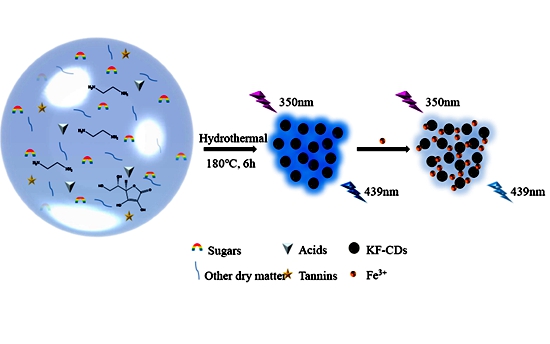Synthesize Fluorescent Nanomaterials from Kiwi to Detect Metal Ions
The team of fruit quality safety control technical is committed to developing multifunctional nanomaterials from biomass carbon sources. This team used kiwi as biomass carbon sources to synthesize a new fluorescent nanomaterials (KF-CDs) that have the great potential in the sensitive detected of Fe3+. From the fluorescence interference experiment, it was obviously quenched by Fe3+ within seconds, and have a good linear relationship between 1-33.8 μmol/L, the linear equation was y=0.9546+0.0689x (R=0.996), and the detection limit was 0.097 μmol/L. The WHO stipulated that Fe3+ in drinking water should not exceed 0.3mg/L (∼5.36 μmol/L).
This work was supported by the Agricultural Science and Technology Innovation Program (Grant CAAS-ASTIP-2019-ZFRI-10) and by the Central Public-interest Scientific Institution Basal Research Fund (No.1610192020107).

Schematic of the synthesis of nanomaterials from kiwi and its applications in Fe3+ sensing
By Wang Caixia (wangcaixia@caas.cn)
-
 Apr 18, 2024Opening Ceremony of the Training Workshop on Wheat Head Scab Resistance Breeding and Pest Control in Africa Held in CAAS
Apr 18, 2024Opening Ceremony of the Training Workshop on Wheat Head Scab Resistance Breeding and Pest Control in Africa Held in CAAS -
 Apr 03, 2024IPPCAAS Co-organized the Training Workshop on Management and Application of Biopesticides in Nepal
Apr 03, 2024IPPCAAS Co-organized the Training Workshop on Management and Application of Biopesticides in Nepal -
 Mar 28, 2024Delegation from the School of Agriculture and Food Science of University College Dublin, Ireland Visit to IAS, CAAS
Mar 28, 2024Delegation from the School of Agriculture and Food Science of University College Dublin, Ireland Visit to IAS, CAAS -
 Mar 25, 2024Director of World Food Prize Foundation visited GSCAAS
Mar 25, 2024Director of World Food Prize Foundation visited GSCAAS -
 Mar 20, 2024Institute of Crop Sciences (ICS) and Syngenta Group Global Seeds Advance Collaborative Research in the Seed Industry
Mar 20, 2024Institute of Crop Sciences (ICS) and Syngenta Group Global Seeds Advance Collaborative Research in the Seed Industry
